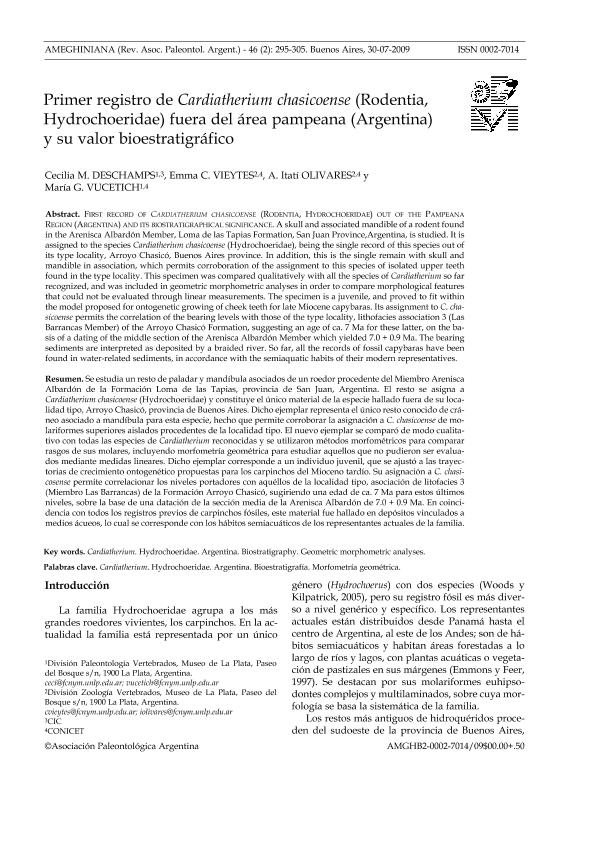Artículo
Se estudia un resto de paladar y mandíbula asociados, de un roedor procedente del Miembro Arenisca Albardón de la Formación Loma de las Tapias, provincia de San Juan. El resto se asigna a Cardiatherium chasicoense (Hydrochoeridae) y constituye el único material de la especie hallado fuera de la región pampeana y de su localidad tipo, Arroyo Chasicó, provincia de Buenos Aires. Dicho ejemplar representa el único resto conocido de cráneo asociado a mandíbula para esta especie, hecho que permite corroborar la asignación a C. chasicoense de molariformes superiores aislados procedentes de la localidad tipo. El nuevo ejemplar se incluyó en estudios cuantitativos con todas las especies de Cardiatherium reconocidas, y en métodos de morfometría geométrica para comparar rasgos anatómicos que no pudieron ser evaluados mediante medidas lineares. Dicho ejemplar corresponde a un individuo juvenil, que se ajustó a la propuesta de crecimiento ontogenético para los carpinchos del Mioceno tardío. Su asignación a C. chasicosense sugiere una edad Chasiquense, en concordancia con una datación de la sección media de la Arenisca Albardón de 7.0 + 0.9 Ma. Los sedimentos portadores fueron depositados por un río entrelazado, igual que todos los registros de carpinchos fósiles, hallados hasta el momento. Esto se corresponde con los hábitos semiacuáticos de los representantes actuales de la familia. A skull and associated mandible of a rodent found in the Arenisca Albardón Member, Loma de las Tapias Formation, San Juan Province,Argentina, is studied. It is assigned to the species Cardiatherium chasicoense (Hydrochoeridae), being the single record of this species out of its type locality, Arroyo Chasicó, Buenos Aires province. In addition, this is the single remain with skull and mandible in association, which permits corroboration of the assignment to this species of isolated upper teeth found in the type locality. This specimen was compared qualitatively with all the species of Cardiatherium so far recognized, and was included in geometric morphometric analyses in order to compare morphological features that could not be evaluated through linear measurements. The specimen is a juvenile, and proved to fit within the model proposed for ontogenetic growing of cheek teeth for late Miocene capybaras. Its assignment to C. chasicoense permits the correlation of the bearing levels with those of the type locality, lithofacies association 3 (Las Barrancas Member) of the Arroyo Chasicó Formation, suggesting an age of ca. 7 Ma for these latter, on the basis of a dating of the middle section of the Arenisca Albardón Member which yielded 7.0 + 0.9 Ma. The bearing sediments are interpreted as deposited by a braided river. So far, all the records of fossil capybaras have been found in water-related sediments, in accordance with the semiaquatic habits of their modern representatives.
Primer registro de Cardiatherium chasicoense (Rodentia, Hydrochoeridae) fuera del área pampeana (Argentina) y su valor bioestratigráfico
Título:
First record of Cardiatherium chasicoense (Rodentia, Hydrochoeridae) out of the pampeana region (Argentina) and its biostratigraphical significance
Deschamps, Cecilia Marcela; Vieytes, Emma Carolina ; Olivares, Adriana Itati
; Olivares, Adriana Itati ; Vucetich, María Guiomar
; Vucetich, María Guiomar
 ; Olivares, Adriana Itati
; Olivares, Adriana Itati ; Vucetich, María Guiomar
; Vucetich, María Guiomar
Fecha de publicación:
12/2009
Editorial:
Asociacion Paleontologica Argentina
Revista:
Ameghiniana
ISSN:
0002-7014
e-ISSN:
1851-8044
Idioma:
Español
Tipo de recurso:
Artículo publicado
Clasificación temática:
Resumen
Palabras clave:
Cardiatherium
,
Hydrochoeridae
,
Bioestratigrafía
,
Morfometría Geométrica
Archivos asociados
Licencia
Identificadores
Colecciones
Articulos(CECOAL)
Articulos de CENTRO DE ECOLOGIA APLICADA DEL LITORAL (I)
Articulos de CENTRO DE ECOLOGIA APLICADA DEL LITORAL (I)
Citación
Deschamps, Cecilia Marcela; Vieytes, Emma Carolina; Olivares, Adriana Itati; Vucetich, María Guiomar; Primer registro de Cardiatherium chasicoense (Rodentia, Hydrochoeridae) fuera del área pampeana (Argentina) y su valor bioestratigráfico; Asociacion Paleontologica Argentina; Ameghiniana; 46; 2; 12-2009; 295-305
Compartir



